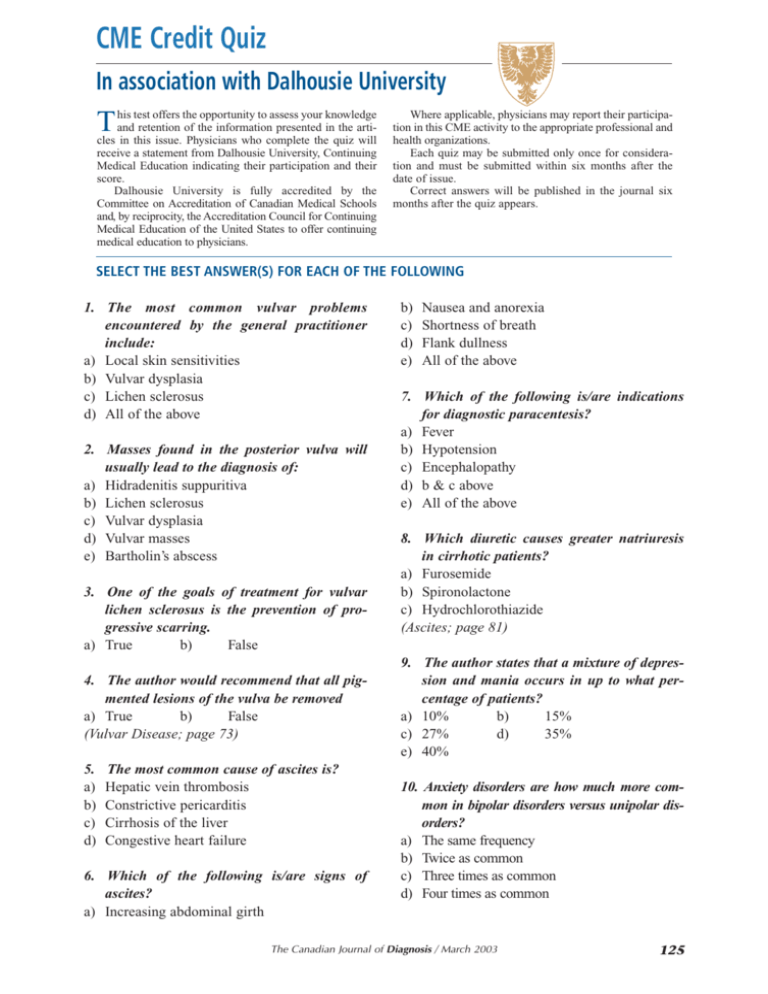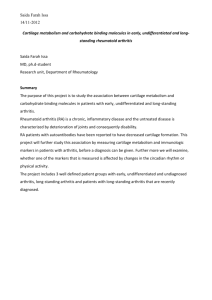CME Credit Quiz - STA HealthCare Communications
advertisement

CME Credit Quiz In association with Dalhousie University his test offers the opportunity to assess your knowledge and retention of the information presented in the articles in this issue. Physicians who complete the quiz will receive a statement from Dalhousie University, Continuing Medical Education indicating their participation and their score. Dalhousie University is fully accredited by the Committee on Accreditation of Canadian Medical Schools and, by reciprocity, the Accreditation Council for Continuing Medical Education of the United States to offer continuing medical education to physicians. T Where applicable, physicians may report their participation in this CME activity to the appropriate professional and health organizations. Each quiz may be submitted only once for consideration and must be submitted within six months after the date of issue. Correct answers will be published in the journal six months after the quiz appears. SELECT THE BEST ANSWER(S) FOR EACH OF THE FOLLOWING 1. The most common vulvar problems encountered by the general practitioner include: a) Local skin sensitivities b) Vulvar dysplasia c) Lichen sclerosus d) All of the above 2. Masses found in the posterior vulva will usually lead to the diagnosis of: a) Hidradenitis suppuritiva b) Lichen sclerosus c) Vulvar dysplasia d) Vulvar masses e) Bartholin’s abscess 3. One of the goals of treatment for vulvar lichen sclerosus is the prevention of progressive scarring. a) True b) False 4. The author would recommend that all pigmented lesions of the vulva be removed a) True b) False (Vulvar Disease; page 73) 5. a) b) c) d) The most common cause of ascites is? Hepatic vein thrombosis Constrictive pericarditis Cirrhosis of the liver Congestive heart failure 6. Which of the following is/are signs of ascites? a) Increasing abdominal girth b) c) d) e) Nausea and anorexia Shortness of breath Flank dullness All of the above 7. Which of the following is/are indications for diagnostic paracentesis? a) Fever b) Hypotension c) Encephalopathy d) b & c above e) All of the above 8. Which diuretic causes greater natriuresis in cirrhotic patients? a) Furosemide b) Spironolactone c) Hydrochlorothiazide (Ascites; page 81) 9. The author states that a mixture of depression and mania occurs in up to what percentage of patients? a) 10% b) 15% c) 27% d) 35% e) 40% 10. Anxiety disorders are how much more common in bipolar disorders versus unipolar disorders? a) The same frequency b) Twice as common c) Three times as common d) Four times as common The Canadian Journal of Diagnosis / March 2003 125 CME Credit Quiz 11. The author states that without psychotherapy it is rare for patients to recover. a) True b) False 12. Which of the following chemicals is a cornerstone in the treatment of bipolar disorders yet has a lack of efficiency as high as 40%? a) Lithium b) Carbamazepine c) Valproate d) Risperidone (Bipolar Disorders; page 93) 13. Recurrence of the skin rash in the same location is typical of: a) Lichen sclerosus b) Herpes zoster c) Leiomyomas d) Scabies 14. If window glass prevents a sun-induced eruption it must be caused by? a) UVA b) UVB 15. Which of the following skin conditions can be suggested by a family history of these conditions? a) Psoriasis b) Atopic dermatitis c) Scabies d) a & b e) All of the above 17. Which of the following is/are examples of articular joint pain/impairment? a) Impairment is much greater for a particular joint movement than others b) Active and passive movement are both impaired c) Equal impairment in all ranges of movement d) b & c above e) All of the above 18. An arthritic pain that is maximal in the morning, lasting more than an hour, and improving as the day goes on suggests which type of arthritis? a) Degenerative b) Inflammatory arthritis 19. A gradual onset of symptoms is more typical of: a) Osteoarthritis b) Crystalline arthritis c) Rheumatoid arthritis d) Trauma e) a & c above 20. A polyarticular arthritis that is asymmetrical with prominent axial involvement and/or distal interphalangeal involvement tends to be: a) Septic arthritis b) Crystalline arthritis c) Osteoarthritis d) Trauma e) Rheumatoid arthritis (Arthritis; page 113) 16. The following characteristics describe which skin disorder; chronic, lesions may extend when pressure is applied to the periphery, sun can aggravate the condition, blisters usually develop on normal appearing skin, secondary painful erosions. a) Plaque psoriasis b) Pemphigus vulgaris c) Atopic dermatitis (Skin problems; page 102) Please indicate your answers on the attached quiz reply form and mail to: Dalhousie University Continuing Medical Education 5849 University Avenue Halifax, Nova Scotia, B3H 4H7 Made possible through an educational grant from MERCK FROSST CANADA LTD.











